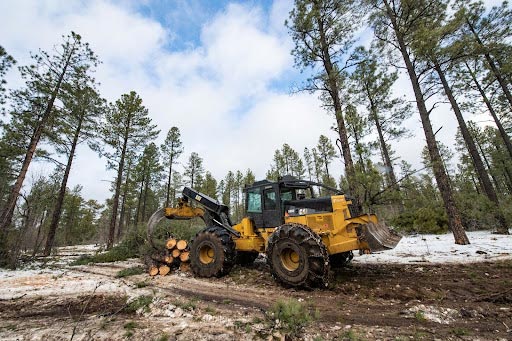
Reducing Slips, Trips and Falls, and Associated Injuries in the Logging Industry
By Brie Weisman, OTR/L with Maine AgrAbility

In the last issue we discussed best practices to reduce slips, trips and falls (STFs) on the job. This month we’ll cover exercises for a strong and limber core. Strength and agility dramatically reduce both the likelihood and the severity of STFs. Because falls can be reduced but not eliminated entirely, we’ll also discuss how to fall correctly to minimize injuries.
EXERCISES FOR BALANCE AND AGILITY
For aging loggers, balance and agility exercises help counter muscle loss and slower reaction time. For loggers of any age or fitness level, they improve performance in the midst of accidents and emergencies. They also have the valuable benefit of leaving you feeling less tired and sore after long or strenuous workdays.
- Do bicep curls with dumbbells while balancing on one foot.
- Stand on one leg while slowly moving the raised foot forward/backward and side-to-side. Increase the level of difficulty by standing on a pillow or exercise equipment designed for improving balance, such as a wobble board.
- Squats. (Beginner squats: from a stand to sit and sit to stand with a standard kitchen chair, without using arms. Progress to not sitting back on a chair for as many reps as possible, until you can perform full sets of standard squats.) As you bend, keep knees centered over ankles–don’t lean forward so they extend over toes.
- Heel-toe walking, forwards and backwards.
- Play with the kids! Jumprope, dance, hopscotch, run obstacles, dodgeball, etc. If you feel the need to let kids win, try your utmost on your own as well, after playtime. If young kids are legitimately beating you, practice until they can’t!
- Stretching/yoga. Increased flexibility means greater range of motion and faster reflexes.This not only reduces STFs overall, it also results in a greater ability to recover from a slip or a trip, as well as increased ability to react well in a fall. It also reduces the overall risk of injury and soreness outside of STFs. Please download our Yoga for Farmers poster or request a copy. Farmers and loggers have similar aches and pains and similar work tasks.
We will be providing a more specific Yoga for Loggers poster in 2023.
HOW TO FALL
The difference between a good and bad fall isn’t luck, it’s a cool head and planning.
- LOOK. The moment balance is lost and a fall is imminent, take charge. Seek a safe location toward which to direct your fall, away from people and hazards.
- DIRECT your fall by turning/leaning into the direction you want to go. If necessary, swing arms in that direction to create directional momentum.
- RELAX. Fall relaxed, loosely curled up, rolling into the fall, to a side if possible.
- PROTECT. Use a shoulder to protect your head if necessary.
- If you cannot fall as described above, try to land on soft, fleshy body parts, like buttocks or shoulders.
- AVOID using arms to break falls! That risks breaking or otherwise injuring shoulders, wrists, fingers, and the long bones of the arms.
- PRACTICE. Gymnasts, martial artists, and other athletes train how to fall correctly. Seek out a personal trainer with these skills.
AFTER YOU FALL
Fight the impulse to spring up as if nothing happened. Excitement, fear, and embarrassment all cloud judgment; adrenaline masks serious injuries. Rushing to your feet on a sprain or break can significantly worsen that injury. In the event of a hard fall or a direct blow to the head, neck, or spine, the possibility of a spinal or head injury is very real. In the event of any fall, follow basic first aid protocol for a full bodily inventory for injuries (https://www.redcross.org/take-a-class/first-aid). It is preferable that someone else perform the inventory on you as you lie still. This is especially true if the fall involves the head, neck, or back. Immediate medical attention should always be sought for black outs, dizziness, nausea, headaches, tenderness to touch on the spine or head, or visible spine or head injuries. A wealth of data shows that the best hope for complete or the greatest possible recovery from concussions and other serious head injuries lies in receiving medical attention as soon as possible.
